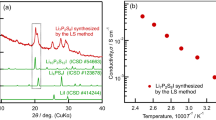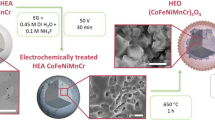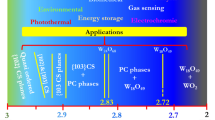Abstract
Divalent tin fluorides and chloride fluorides appear to be stable relative to oxidation to tetravalent tin at ambient temperature. X-ray diffraction shows only the line of the tin(II) compound, however the 119Sn Mössbauer spectrum of all tin(II) polycrystalline samples has a small broad peak at ca. 0 mm/s. This is the case of polycrystalline α −SnF2, while the spectrum of a large single crystal polished sufficiently thin shows only the tin(II) doublet, with no SnO2 peak at 0 mm/s. This shows that there is surface oxidation of each solid particle, to give a thin amorphous layer of SnO2 stannic oxide. However, the Mössbauer peak of SnO2 does not grow with prolonged exposure to air at ambient temperature, therefore it must be assumed that the layer of SnO2 has a passivating effect, however oxidation increases at higher temperatures. We have investigated in this work the passivating effect of a layer of SnO2 in two types of solid solutions: (i) in the fluorite type M1−xSnxF2, where the amount of tin at low x values is not sufficient to provide full coverage of the surface of the particles, and (ii) in the PbClF type doubly disordered solid solution, Ba1−xSnxCl1+yF1−y. It was found that passivation works well in the M1−xSnxF2 solid solution, however most of the time, it does not work so well for Ba1−xSnxCl1+yF1−y where it is strongly dependent on the method of preparation and the bonding strength, as shown by the variation versus the tin(II) recoil-free fraction.
Similar content being viewed by others
References
Dirac, P.A.M.: Principles of Quantum Mechanics. International Series of Monographs on Physics, 4th edn., p. 255 Oxford University Press (1982)
Dénès, G.: The “Bent Copper Tube”: an inexpensive and convenient reactor for fluorides of metals in suboxidation states. J. Solid State Chem. 77, 54–59 (1988)
Birchall, T., Dénès, G., Ruebenbauer, K., Pannetier, J.: A tin-119 Mössbauer study of the phase transitions in SnF2. J. Chem. Soc. Dalton, 1831–1836 (1981)
Dénès, G., Bell, M.F., Sayer, M.: BaSnF4 – a new fluoride ionic conductor with the α–PbSnF4 structure. Solid State Ion. 13, 213–219 (1984)
Birchall, T., Dénès, G., Ruebenbauer, K., Pannetier, J.: Tin-119 Mössbauer spectroscopic study of a single crystal of α–SnF2 and partially oriented α–PbSnF4. J. Chem. Soc. Dalton, 2296–2299 (1981)
Birchall, T., Dénès, G: A 19F, 119Sn nuclear magnetic resonance and 119Sn Mössbauer study of the SnF2 - MF – H2O system. Can. J. Chem. 62, 591–595 (1984)
Lengyel, L., Homonnay, Z., Kuzmann, E., Klencsar, Z., Sipos, P., Bajnoczi, E.G., Palinko, J.: Goldanskii-Karyagin effect in hyperalkaline tin(II) hydroxide. J. Radioanal. Nucl. Chem. 307, 1195–1201 (2016)
Dénès, G., Madamba, M.C.: X-ray diffraction study of phase transformations in superionic PbSnF4 upon milling and subsequent annealing. Mater. Struct. 3, 227–245 (1996)
Dénès, G., Ruebenbauer, K.: GMFP5, an extension of GMFP 58 to five hyperfine sites, unpublished results
Ruebenbauer, K., Birchall, T.: A computer programme for the evaluation of Mössbauer data. Hyperf. Interact. 7, 125–133 (1979)
Galy, J., Meunier, G., Andersson, S., Aström, A.: Stéréochimie des éléments comportant des paires non liées: Ge(II), As(III), Se(IV), Br(V), Sn(II), Sb(III), Te(IV), I(V), Xe(VI), Pb(II) et Bi(III) (oxydes, fluorures et oxyfluorures). J. Solid State Chem. 13, 142–159 (1975)
Gillespie, R.J., Nyholm, R.S.: Inorganic stereochemistry. Quart. Rev. Chem. Soc. 11, 339–380 (1957)
Brown, I.D.: Bond valence as an aid to understanding the stereochemistry of O and F complexes of Sn(II), Sb(III), Te(IV), I(V) and Xe(VI). J. Solid State Chem. 11, 214–233 (1974)
Dénès, G., Pannetier, J., Lucas, J., Le Marouille, J.Y.: About SnF2 stannous fluoride. I. Crystallochemistry of α–SnF2. J. Sol. State Chem. 30, 335–343 (1979)
Birchall, T., Dénès, G., Ruebenbauer, K., Pannetier, J.: Goldanskii-Karyagin effect in α–SnF2: a neutron diffraction and Mössbauer absorption study. Hyp. Interact. 30, 167–183 (1986)
Goldanskii, V.I., Marakov, E.F., Stukan, R.A., Samakosova, T.N., Trakhtanov, V.A., Khrapov, VV: The Mössbauer effect and its applications. Proc. Acad. Sci. USSR 156, 474 (1964)
Greenwood, N.N., Gibb, T.C.: Mössbauer Spectroscopy, p 375. Chapman and Hall, London (1971)
Dénès, G.: About SnF2 stannous fluoride. I. Phase transitions. Mater. Res. Bull. 15, 807–819 (1980)
Weast, R.C., Astle, M.J. (eds.): CRC Handbook of Chemistry and Physics, 61st edn. CRC Press, Boca Raton (Unknown Month 1980)
Muntasar, A., Le Roux, D., Dénès, G.: Stabilization of the unhybridized Sn2+ stannous ion in the BaClF structure and its characterization by 119Sn Mössbauer spectroscopy. J. Radioanal. Nucl. Chem. 190, 431–437 (1995)
Dénès, G., Muntasar, A.: X-ray diffraction and Mössbauer spectroscopic studies of Sn/Ba and Cl/F substitutions in BaClF. Mater. Struct. 3, 246 (1996)
Dénès, G., Muntasar, A.: Bonding in the doubly disordered Ba1−xSnxCl1 + y F 1−y solid solution. Hyp. Interact. 153, 91–119 (2004)
Shannon, R.D., Prewitt, C.T.: Effective ionic radii in oxides and fluorides. Acta Cryst. B 25, 925–946 (1970)
Acknowledgements
This work is dedicated to the memory of Prof. Krzysztof Ruebenbauer, Pedagogical University, Krakow, Poland, who passed away on April 23, 2018. He contributed so much to our understanding of the Mössbauer effect in divalent tin materials.
This work was made possible by the support of Concordia University and the Natural Science and Engineering Research Council of Canada. Grateful thanks are also due to the Procter and Gamble Co. (Mason, Ohio) for supporting our Mössbauer laboratory.
Author information
Authors and Affiliations
Corresponding author
Additional information
This article is part of the Topical Collection on Proceedings of the 4th Mediterranean Conference on the Applications of the Mössbauer Effect (MECAME 2018), Zadar, Croatia, 27-31 May 2018
Edited by Mira Ristic and Stjepko Krehula
Rights and permissions
About this article
Cite this article
Dénès, G., Muntasar, A., Madamba, M.C. et al. Oxidation and passivating effect in tin(II) fluoride and chloride fluoride solid solutions: a 119Sn Mössbauer study. Hyperfine Interact 239, 46 (2018). https://doi.org/10.1007/s10751-018-1513-3
Published:
DOI: https://doi.org/10.1007/s10751-018-1513-3




